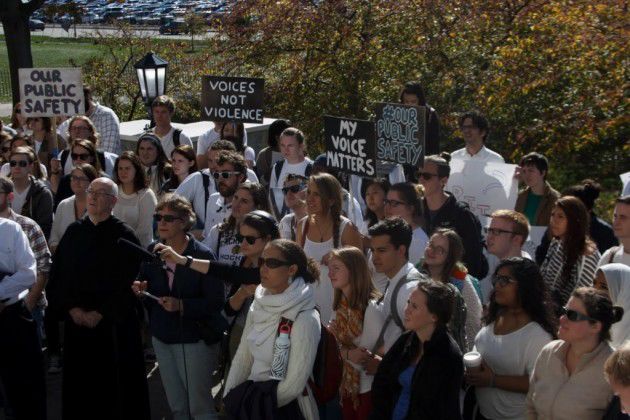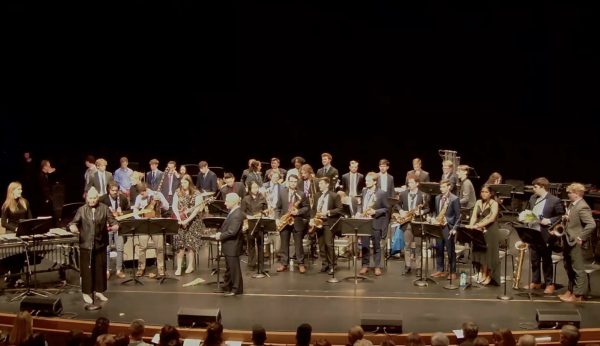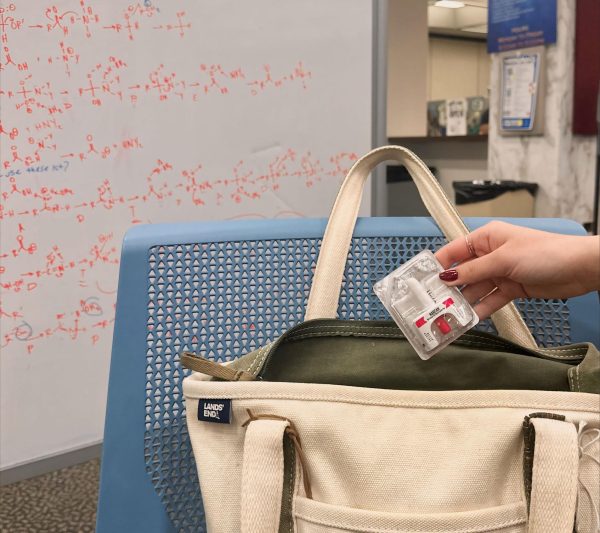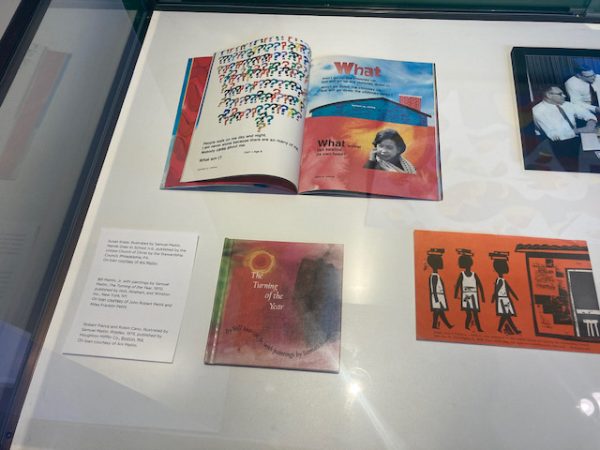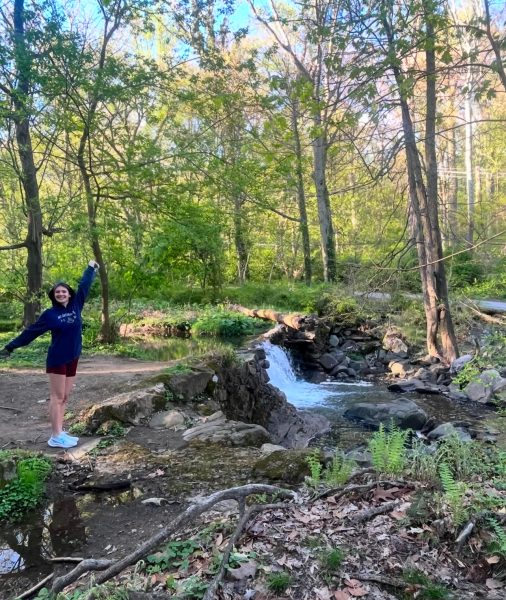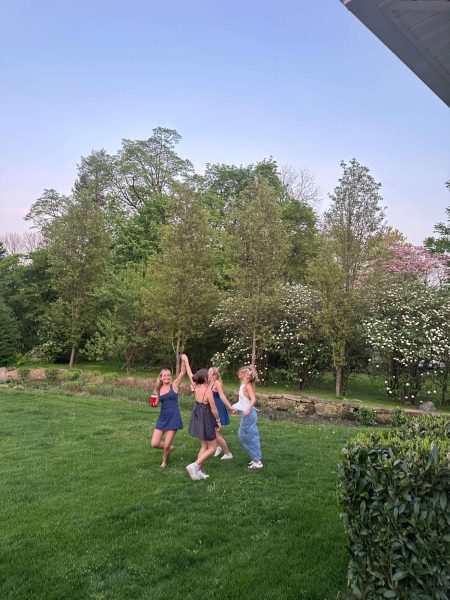Students find their voices in march against arming Public Safety
October 27, 2015

The only sound that could be heard from the procession of protestors marching from the St. Thomas of Villanova church across campus was the rippling of white paper banners moving against the fall wind. The banners shook and crunched as the crowd carried their messages, allowing the words “Our Public Safety,” “My Voice Matters” and “Ignite Change Not Fear” to speak for them and relay their anger as they walked in silent unison.
The March Against the Decision to Arm Public Safety began on the steps of the St. Thomas of Villanova Church on Friday, Oct. 23rd at 11:30 a.m. with a prayer of nonviolence led by Father Joe Calderone. He spoke to the crowd of about 125 students, faculty and professors, urging the community to “follow our God, armed with peace and justice.”
This protest was intended as a response to an email sent out by University President Rev. Peter M. Donohue, O.S.A., Ph.D., and the University’s Board of Trustees on Monday, Oct. 19th to the Villanova community. The email explained the President’s decision to approve “establishing a University police department that will be armed.” Donohue noted the recent threat to Philadelphia-area schools and tragic events at universities across the country as influential factors in the administration’s decision to arm 20 percent of the 75-member Public Safety Department in order to maintain the safety of the Villanova community. This change is set to take place beginning in the fall of 2016.
Students’ negative reactions to this email served as a source of inspiration for the protest.
“That email just felt like manipulation,” Caitlin Mitchell, a participant in the demonstration, noted. “The Villanova community was not involved at all.”
Silence fell over the crowd as they began their protest, walking across the University’s campus. The confused and judgmental glances of students and flashes of cameras could not extinguish the determination of the group as they circled around the Oreo, standing in a closed circle, hand in hand in matching white shirts, signifying their desire for peace.
Ten minutes passed, and two tour groups passed by the Oreo. Prospective students and their parents glanced towards the crowd in confusion. Students sitting on benches and tables across from the group watched in curiosity. Despite the attention, the group maintained a passionate stillness.
Kate Walsh, a senior Humanities major and active leader in the organization of the march, explained why the group chose to use a silent march to bring attention to their cause. “We wanted to avoid being associated with violence or disruption in any way and represent our sincere belief that our voices have not yet been heard on this issue,”she said.
After those ten minutes, a voice cracked through the noiseless air, saying, “It is time that our voices are heard.”
The students broke their silence by presenting a letter of discontent and concern addressed to Donohue. The letter explained the students’ and faculty members’ core issues with the decision to arm public safety officers, saying “we are deeply troubled by this recent decision, as we believe that it is not in keeping with the core values of our community. We feel that it would be a betrayal to our commitment to fostering truth, unity and love in our community if we fail to speak out against both the process and the decision.”
The letter addressed the protestors’ concerns with the lack of communication and transparency between the administration and the Villanova community, noting that open forums on the topic took place two years prior to the decision, at a time where half of the student body did not attend the University and therefore were not taken into consideration in the decision making process.
They added that they “believe that the resort to armed protection in a response to fear—a phenomenon that is growing throughout the country—is neither a viable nor a desirable solution to the problem of gun violence on campuses.” They cited quotations from leaders of peace throughout history, like Dr. Martin Luther King and Pope Francis, to support their argument for disarmament. They added that they “feel establishing an armed police department places us in an arms race without end, rather than fostering bonds of friendship and love despite, and in protest of, the evils of others.”
“Rather than promoting our core Catholic Augustinian values of truth, unity, and love, this decision promotes a culture of fear that is prevalent throughout our country,” Walsh noted.
The students leading the protest noted that Donohue has not yet responded to the letter, nor was he present for the protest.
Next, junior Kinjal Dave, the creator and organizer of the Facebook event advertising the march to the Villanova community, explained the three goals the protestors seek to achieve: immediate transparency between administration and the Villanova community, student involvement in decision-making processes in the future, and ultimately, the reversal of this decision to create an armed university police department.
Dave explained her desire to speak out against the University’s decision, saying, “In the long run, this adds to this false narrative that having more guns will make us safer. Now the police will have arrest capabilities, and I don’t feel comfortable with the idea that a student could have a stupid drunken encounter with a public safety officer that could lead to arrests or an arrest record.”
“The risk of racial profiling is also strong, especially in a predominantly white campus,” she added. “With guns there’s an immediate threat of profiling in a situation escalating to fatality.”
Junior Brendan Carchidi expressed similar concerns for minority students on campus in regards to this decision, adding, “The fact of the matter is that racial profiling has and will continue to exist on this campus. Arming a public safety officer, or even hiring sworn-in officers will only escalate these instances of racial profiling, intensify the psychological suffering of people of color on campus and ultimately hurt our community in a significant way.”
As the demonstration came to a close, the students urged the Villanova community to continue this discussion and to work towards achieving their goal of revising the decision. Students who participated in the presentation joined together to sign a white banner of protest bearing the words “Our Public Safety.” The banner was covered with words and phrases such as “love,” “no to fear,” “communication,” “Respect,” and “Unitas Caritas Veritas.”
In regards to the success of the event, Walsh noted, “On one hand, I was really excited to see so many people who genuinely cared about the decision and how it would affect our community. On the other hand, of course I would have loved to see more people take part on Friday. I want people to know that even if this decision does not change, we can, and should, be involved in the way it is implemented.”
“I was pleased with the protest, because this was an exercise of community,” Carchidi noted. “The whole point of the protest was community. We want to build a strong, safe community, but we want to do that as a collective and inclusive community–not just a few select individuals from the administration. But there are no results just yet. Community building is a life-long pursuit, not just within the parameters of an hour-long demonstration despite its significant effects.”

